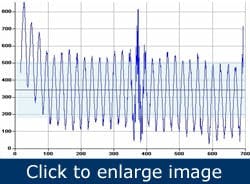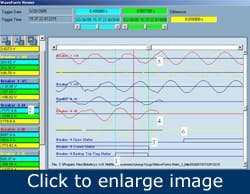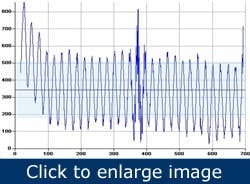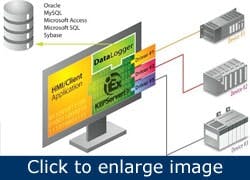Operators use diagnostic data to optimize production and eliminate maintenance problems before they start
Equipment condition is monitored conventionally to avoid downtime, reduce repair costs and minimize consequential damages, but what happens when you shift the emphasis from reliability to productivity? Instead of predicting and planning maintenance work, condition-monitoring principles and technologies can inform operators directly, so they can make machine, process or operation adjustments, continue to run and maintain quality levels.
The key is to automate data analysis and render condition information in the form of notifications or instructions operators can act on in real time — to the extent possible, taking maintenance out of the loop and closing it directly between the machine and the operator.
“By managing our equipment below the alert level, we are able to be proactive,” says Jayesh Patel, reliability engineer at Valero’s Paulsboro, N.J., refinery. “This allows us to move away from reactive work and its associated process interuptions. The results of this shift to proactive are improved product quality, improved machinery availability and increased profits.”
Use today’s technology to mimic the way a human would perform diagnostics. “We’re headed in that direction,” says Don Rainey, director, Azima DLI. “The whole condition-monitoring industry will be.”
Banish squiggly lines
Source: GE
This example of an actual in-service fault on a low-voltage power circuit breaker illustrates how you can use advanced waveform capture tools to fully evaluate breaker performance using six key data points.
- The trip initiation point. This is where the trip relay first detected the fault over the setting threshold. In this particular example, it’s an instantaneous overcurrent trip, so there’s no intentional time delay.
- The current magnitude that initiated the trip. On this example, the A phase current exceeded the pick-up threshold, and this triggered the instantaneous trip element in the electronic trip relay.
- The transition of the closed auxiliary contact status to an open state. This auxiliary contact transitions early in opening operation of the breaker mechanism. This transition point is an excellent measure of trip coil performance and the mechanical latch performance of the circuit breaker mechanism. There are many anecdotes in the electrical industry about “sticky latches” and slow circuit breakers, but this type of detailed data permits factual evaluation of breaker performance. In this case the auxiliary contact transitions in 16.9 ms. This particular breaker has been in normal service for more than 20 years with no special maintenance or rebuilding and the 16.9 ms is well within the baseline established for new breakers.
- The extinction of the fault current. This is possibly the most important feature of the waveform. Together, this information and the initiation point of the trip indicate the total performance of the breaker mechanical and current interrupting performance. In this case, the breaker interrupted the current in 24.2 ms, well within the 50 ms clearing time of the published time-current curve. It should be noted, however, that this is a single data point for one set of conditions, so one shouldn’t conclude that the clearing time is 24 ms, not 50 ms, under all fault conditions.
- The transition to system voltage when the current is extinguished. In this case, the current is interrupted quickly and there’s a quick transition back to system voltage. The combinations of the current extinction and voltage transition are indicators of the breaker interrupter performance and dielectric performance. If the current wasn’t extinguished rapidly and the voltage didn’t recover quickly, it would indicate potential interrupter or dielectric problems with the breaker.
- The open contact transitions from open to closed. This occurs near the end of the breaker’s mechanical open cycle and is indicative of the breaker mechanism performance. This transition occurred 34.8 ms after the trip initiation, showing that the breaker was fully open within the 50 ms published clearing time.
How equipment is operated has a profound effect on reliability. “We know 40% to 50% of breakdowns are caused by operating practices, pushing the limits to make product,” says Dan Nower, P.E., global manager, online systems, Emerson. One reason operators lean on the plant is they don’t understand the consequences because they don’t speak the same language as maintenance and reliability experts. “Squiggly lines — spectra and waveforms — make their eyes glaze over,” says Nower, “So use the DCS; that’s the operator’s language.”
So, how do we take tried and true methods such as vibration and temperature and make them relevant to the operator so they can use them and normal instrument guys can support them?
“We have to integrate the system and route the information, and that’s where changes are happening,” says Tom Alford, product manager, integrated condition monitoring, Rockwell Automation. “For example, our RS Logix 5000, which manages controller configuration and I/O, now has an add-on profile for condition-monitoring modules.”
That information can be used to drive diagnostics. For example, high vibration levels indicate a problem, and the frequency ranges can be correlated to specific faults. “Put those in the controller table, and now control logic can be used,” says Alford. “Real-time diagnostics use if-then statements to identify specific faults — for example, if vibration is high and Band 1 is high, that means imbalance.”
Smart systems can help fill the need for knowledgeable people. “With the attrition we’re seeing to the skilled workforce, we’re going to need this,” says Gina Hutto, manager, business development, services group, Timken. “Operators are the first line. We’re doing this, for example, on rollers in steel mills. We’re monitoring continuously where we used to have technicians performing rounds, and the system feeds directly into the control rooms, on the operator’s screen.”
A process control system can monitor any of thousands of variables for both prediction and protection. It can monitor machine health and know its exact condition, and it also can protect high-value assets by shutting them down automatically to prevent damage.
“In the past, it was hard to do, so people didn’t do it,” says Nower. “Now, in minutes, we can pull variables into the controls so we’re speaking the operators’ language on their system – a green, yellow or red light.”
Deliver actionable information
Operators also can make use of condition information they collect using simplified devices to measure variables such as overall vibration and temperature. “Operators are getting out there, doing rounds, collecting data with PDAs and getting it into the system,” says Scott Brady, senior manager, operator-driven reliability, SKF. “They can collect data every day, whereas maintenance crews usually only take machine readings every two to six weeks, and sometimes machinery changes more quickly than that.”
The key is electronic data entry. Once the data is on the system, it can be analyzed and acted upon. “In applications involving rounds, a lot of the data — 40% to 80% — is often paper-based,” says Chris Stearns, product manager, reliability solutions, Honeywell. This can be automated. “For example, our Field Advisor lets you identify structured rounds, get the information into our Experion system historian, onto operations desktops and into logs,” says Stearns. “Collect, synchronize and get it into databases.”
Wireless infrastructure enables other applications. “It’s good to have the infrastructure. Then wireless equipment health monitoring (EHM) is cost-effective,” says Stearns. Data comes back into the asset manager application and is presented as health indicators on the control system or in a thin-client application.
OK, you’ve turned a squiggly line into a colored indicator; now what do you do with it? If you can, you tell operators what action to take. They then can alleviate the condition or get the right people involved before the asset fails and consequential damages occur.
{pb}When operators see an alert or danger, they can get instructions about what to do — clean something, adjust a valve, contact a supervisor. “On entering an area, they can get safety instructions; they can be told whom to notify and what to turn off,” says Brady. “They also can have pictures of what to look at, keyed to equipment bar codes, RFID, and, in some outdoor applications, GPS. When they’re leaving, they can get a reminder of what to turn back on.”
Wireless opens the plant to unimagined possibilities. “We’re only scratching the surface with wired and paper-based systems,” concludes Stearns. “There’s so much that isn’t in the system.”
Improve reliability
Operators can use condition information not only to predict breakdowns so repairs can be planned, but to prevent them from happening at all. “Condition monitoring is sold on the basis of avoiding catastrophic failures, but it offers as much or more value by allowing a machine to continue to run,” says Azima DLI’s Rainey. “We detect a defect and, by monitoring it, allow the machine to continue to operate to minimize the cost of correcting it. This happens often and has a major effect on productivity.”
For example, power can be monitored to detect changes in the condition of electrical equipment such as circuit breakers. Over time, the mechanical condition of the breaker degrades. Corrosion can reduce smoothness, and it might not open as quickly. “By capturing the wave form every time a breaker is opened, we can track degradation,” says Jane Barber, product manager, Entellisys low-voltage switchgear, GE Industrial Solutions. “We can measure how much energy goes through the arc path to measure electrical condition and count breaker actuations under fault and under no-load conditions to track mechanical condition.”
The current, the instant of trip initiation, the current and voltage during the trip, and the mechanical transitions are key elements. Collecting this data over time offers the ability to determine how much breaker life has been used and, more importantly, how much is left. “This waveform capture has to be performed by the protective relay itself,” says Barber. “The data collected by meters or data loggers doesn’t typically include these key elements.” An example is described in the sidebar, “Breakers Reveal True Spirits.”
[pullquote]In another example, Honeywell’s specialty materials facility in Hopewell, Va., was spending $50,000 in lost production plus repair costs each time a fan failed because of material buildup. “If they could see the problem early enough, they could find an opportunity and remotely flush the fan. They added a wireless equipment health monitoring (EHM) system, and now they can flush the fan with no cost to production or maintenance.
The EHM notifies operators through the company’s Field Advisor system, which records critical asset data and ensures it falls within safe operating limits. If the equipment is operating outside the plant’s set limits, the system guides the operator through the steps necessary to correct the problem.
“When an asset exceeds critical operating limits, the appropriate actions aren’t always apparent to the operator and the wrong decision could have a wide range of consequences,” says Paul Brice, director of advanced solutions, Honeywell Process Solutions. “Field Advisor ensures the operator considers operating limits up front, which can improve overall production.”
Another mill had a problem in the induced-draft fan feeding an emissions-control baghouse. It couldn’t run without this fan, and it would cost $1 million a day in lost opportunity to take the mill down. “We were able to monitor the fan and run three more weeks to reach a scheduled outage,” says Rainey. “Knowing you can do nothing can have a higher ROI than knowing what to do.”
Stay in spec
Of course, there’s no point in keeping equipment running if it’s producing scrap, so plants are increasingly applying condition monitoring to a wide variety of machine and process variables to alert operators and keep quality high.
It can be as simple as detecting buildup on wheels used for sanding laminate. “The operator gets a green/yellow/red indicator,” says Rockwell Automation’s Alford. “The controller can give recommendations. You’re yellow and it’s imbalance — that means dust buildup on the sander wheels, it’s time to stop and clean out the wheels before you start to get chatter marks in your laminate. You don’t need a $20,000 data collector, $15,000 in software and $15,000 worth of training to learn when to clean a sander wheel — just expertise to understand the signatures and faults. Then you institutionalize it. We’ve done this for several customers, and demand is increasing.”
Motor current characteristics are being used to monitor machine tools for vibration and backlash. “We’re able to detect several problems on machine tools using diagnostics on the controls to monitor different types of signals and to run tests, to detect problems before the machine gets into a situation where it doesn’t run,” says Jon Cruthers, business development manager, Siemens Industry.
{pb}Figure 1. An equability test measures feedback signals across an axis of motion that might indicate resistance. This signal shows it’s time to clean the chips from an actuator cover. Source: Siemens Industry
An equability test measures feedback signals across an axis of motion that might indicate resistance, for example, from backed-up chips or seized segments of an actuator cover (Figure 1). When such a problem occurs, people usually look at the tool first, says Cruthers. “Instead, you can pinpoint the root cause and go directly there,” he explains. The system can dispatch a message to the operator, to maintenance or to Siemens to tell the appropriate person what needs attention before the part finish is affected, while the operator is still making good parts.
The system can use information from other places and from third-party inputs such as vibration monitors. Similar technology is being used outside of machine tools, for example, on wind turbines, to monitor, report and dispatch crews. “Failures there can be costly,” adds Cruthers. “With crane work, it’s hundreds of thousands of dollars.”
A similar approach is preventing striations in sheet metal used for automotive and white goods applications. Roll chatter in tandem mills that cold-roll the steel causes gauge variations — chatter marks — that would show up as striations in a car door or refrigerator panel. The rolling mill system would alarm on excessive vibration, or quality control would observe chatter marks; then the rolls would be changed.
“It is also chatter prevention, not just chatter detection,” says Jonathan Davis, CEO of ITR. “Now, a vibration monitoring system on the mill identifies and quantifies the vibration in a display in the operators’ pulpit. The operator can change parameters such as speed or roll force to stay away from chatter.”
The chatter is not violent, third-octave chatter. It’s fifth-octave, back-up roll chatter. The system watches the third and fifth octaves and how the forcing functions — roll speed, bearing defects, gear mesh — interact with the natural frequencies of the mill. The resulting chatter imprints the back-up rolls at about 1-1/2-in. spacing. “To detect chatter, we know the circumference of the backup rolls and calculate the frequency of the chatter to see if it is imprinted on the back-up rolls,” says Gordon MacQuarrie, senior analyst and account manager at ITR.
To prevent chatter, operators have a computer model of the mill and can adjust parameters using real data before enacting changes. “If the mill approaches resonance, it’s often better to speed up. The resonance builds with speed. Then, when you pass through the resonant frequency, a phase shift makes the vibration drop off dramatically. If you slow down, you’re still in the excitation range. Adding more speed moves the mill past the influence of the natural frequency. Continuing to operate the mill in an excited state will eventually result in roll chatter.”
ITR is working on adding inputs to the rolling mill control system to make it more automatic. Meanwhile, operator experience teaches them how to react. The system can be monitored remotely and reports the percentage of a coil in alarm that was rolled.
Alford says 80% of failure modes occur over weeks and don’t affect quality, but 20% fail quickly and result in scrap. “The big difference is in this 20%,” he says.
Optimize production
Monitoring process variables opens opportunities to why equipment under- or overperforms. “Not just impending problems, but using the same technology to measure real-time performance and efficiencies,” says Azima DLI’s Rainey. “Why is one pump more efficient? Why does this paper machine make better quality?”
For example, at a steel mill, 5,000-hp, 4,160-V pumps running 24/7 consume millions of dollars’ worth of electricity. “So if we can identify a pump that’s not running as efficiently as its neighbor — just a few percent — we can save $30,000 or more per year,” says Rainey.
In another case, a tissue producer was limiting the maximum speed — feet per minute — on a large machine because of vibration. “We were able to find the origin of the vibration, characterize it and tell them how to stiffen the bearing mounts and structure to mitigate it,” says Rainey. “They were able to raise the speed, and therefore the production, by 10%.”
Source: Kepware
A significant challenge for many integrated condition-monitoring applications is getting information from additional sensors or islands of automation into a system where it can be analyzed and reported.
“As a driver company connecting PLCs, sensors and APIs in different systems, we’re seeing more moving of information,” says Tony Paine, president, Kepware. “People are monitoring real-time process variables against tolerances and limits, and pushing it up to the operator level where they can monitor alarms and events.”
A large part of industry has standardized on OPC, but they’re also using more proprietary devices such as WonderWare Suitelink and Oracle. “With Kepserver EX, an engineer can determine what information is needed from which device and get it using multiple protocols,” says Paine. “Clients can generate state machines and run the logic within our server to notify the operator.”
For example, when Briggs & Stratton (B&S) in Milwaukee chose overall equipment effectiveness as a key performance indicator, Darrell Morris, B&S manufacturing engineer, was asked to find a low-cost system to collect data from the machines on the shop floor automatically.
“I knew that finding a system wouldn’t be a problem, as there are several companies that make software that would fit the bill,” says Morris. “The problem would be the ‘low-cost’ part. I’ve dealt with machine control and software enough to understand that to software vendors, ‘low-cost’ means tens of thousands, rather than hundreds of thousands, but I also know that ‘low-cost’ to my boss often means hundreds of dollars, rather than thousands — thus, the dilemma.”
Morris reviewed solutions from three leading automation software suppliers, but the cost would put each one into a capital project category, where higher-priority activities would prevent it from seeing the light of day. Another solution had to be found.
Morris was aware of one piece of equipment at the plant, delivered as part of an OEM installation, in which the OEM had used Kepware software to communicate from the machine’s PLC to a supervisory PC. On investigation, he found that KEPServerEX offered a range of connectivity to plant floor equipment as well as connectivity to client software applications. In addition to the communication software for machine data collection, the solution supported a plug-in able to push data to a relational database through the open database connectivity (ODBC) standard.
In this case, the system identifies and logs electrical faults, mechanical faults, spindle drive errors, clamp problems and proximity faults. It can monitor Briggs & Stratton’s wide range of equipment, from PLC-based machining centers to the robotics moving components along the line.
Artificial intelligence is being applied to broad swaths of sensor and control system data to discover important changes and correlate them to causes. “You can detect changes in the underlying equipment operation caused by a fault in the equipment or a change in operation, such as forgetting to start a lube oil pump,” says David Bell, vice president, application engineering, SmartSignal. “Low oil levels can give higher-than-normal bearing temperatures. You can detect that and have the operator go out and add oil. Some are efficiency-related — for instance, starting up a steam plant. The drain valves have to be closed manually and people might not close them. You can detect that.”
The approach takes the proactive mindset beyond traditional condition-monitoring technologies. “Those are great, but they’re vertical and specific,” says Bell. “Ours lets you cover a much broader swath.”
Implementation requires:
- A reasonable level of instrumentation that measures variables that reflect change and the process
- Aggregating and accessing the data in, for example, an historian
- Implementing software. “We’ve been doing this for awhile so we have standard template configurations,” says Bell.
- Linking to the variables and sensors, using the historian to train the models and go live with the solution.
In the past few years, SmartSignal has added a monitoring center for companies that want to outsource it and has moved from simply identifying changes to providing diagnostics. For example, in a coal-fired combined cycle plant, it can identify a feedwater leak, indicate its severity, and send an email based on priority to a PDA or computer.
SmartSignal calls it “threat-based maintenance,” says Bell. “These are things that can happen that take life out of your equipment. Detect them early and mitigate them.”
Maximize OEE, minimize TCO
It all comes down to maximizing overall equipment efficiency (OEE) at the lowest total cost of ownership (TCO), not only for a few pieces of critical equipment, but for more of the machines you use to make money.
“The tendency has been to do time-based or use-based preventive maintenance on most assets, with predictive only on critical assets worth $100,000 or more,” says Honeywell’s Stearns. Predictive has been done using dedicated continuous monitoring systems or field rounds and inspections for such things as vibration or oil leaks, for only 1% to 2% of the plant.
But as other technologies, such as wireless-based monitoring, have become more prevalent and less costly, plants invested in them to raise frequency of inspections to once an hour, instead of weekly or monthly rounds. Lower costs are making it possible to address 20% to 30% of assets.
“Align condition monitoring with business objectives,” reminds Rockwell Automation’s Alford. The traditional condition-monitoring strategy — predictive maintenance — continues to be critical for the planned maintenance, which maxes out at about 80%. “The other 20% is business-driven,” he says. “When you have a problem, you need data in real time with immediate feedback to the operator. Then you can stop wasting time, material and opportunity.”Many small and mid-sized manufacturers run skeleton maintenance crews and can’t get into predictive mode. “So, what goes down and causes big problems?” asks Alford. “Put a sensor on it, set up the ladder logic and detect when that bearing begins to deteriorate. It’s not a philosophy; it’s just solving a problem. There are lots of smart guys out there — get that knowledge into ladder logic out at the machine, so we can take action and increase productivity.”



